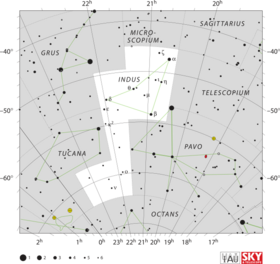Astronomy:Zeta Indi
| Observation data Equinox J2000.0]] (ICRS) | |
|---|---|
| Constellation | Indus |
| Right ascension | 20h 49m 28.96165s[1] |
| Declination | −46° 13′ 36.6083″[1] |
| Apparent magnitude (V) | 4.90[2] |
| Characteristics | |
| Evolutionary stage | giant |
| Spectral type | K5III[3] |
| B−V color index | +1.494±0.059[2] |
| Astrometry | |
| Radial velocity (Rv) | −5.20±2.8[4][2] km/s |
| Proper motion (μ) | RA: +40.050[1] mas/yr Dec.: +28.199[1] mas/yr |
| Parallax (π) | 7.5666 ± 0.2153[1] mas |
| Distance | 430 ± 10 ly (132 ± 4 pc) |
| Absolute magnitude (MV) | −0.61[2] |
| Details | |
| Radius | 44.79+0.86 −5.47[1] R☉ |
| Luminosity | 446±14[1] L☉ |
| Surface gravity (log g) | 1.93[5] cgs |
| Temperature | 3,963+267 −37[1] K |
| Other designations | |
| Database references | |
| SIMBAD | data |
Zeta Indi is a single[7] star in the southern constellation Indus, near the northern constellation border with Microscopium. It is visible to the naked eye as a faint, orange-hued star with an apparent visual magnitude of 4.90.[2] The star is located approximately 430 light years away from the Sun based on parallax.[1] The radial velocity estimate for this object is poorly constrained, but it appears to be moving closer at the rate of around −5 km/s.[2]
This object is an aging giant star with a stellar classification of K5III.[3] With the supply of hydrogen at its core exhausted, the star has expanded off the main sequence and now has 45[1] times the girth of the Sun. It is radiating 446[1] times the luminosity of the Sun from its bloated photosphere at an effective temperature of 3,963 K.[1]
References
- ↑ Jump up to: 1.00 1.01 1.02 1.03 1.04 1.05 1.06 1.07 1.08 1.09 1.10 1.11 Brown, A. G. A. (August 2018). "Gaia Data Release 2: Summary of the contents and survey properties". Astronomy & Astrophysics 616: A1. doi:10.1051/0004-6361/201833051. Bibcode: 2018A&A...616A...1G. Gaia DR2 record for this source at VizieR.
- ↑ Jump up to: 2.0 2.1 2.2 2.3 2.4 2.5 Anderson, E.; Francis, Ch. (May 2012), "XHIP: An extended hipparcos compilation", Astronomy Letters 38 (5): 331–346, doi:10.1134/S1063773712050015, Bibcode: 2012AstL...38..331A. Vizier catalog entry
- ↑ Jump up to: 3.0 3.1 Houk, Nancy (1978), Michigan catalogue of two-dimensional spectral types for the HD stars, 2, Ann Arbor: Dept. of Astronomy, University of Michigan, Bibcode: 1978mcts.book.....H
- ↑ Wilson, R. E. (1953), "General Catalogue of Stellar Radial Velocities", Carnegie Institute Washington D.C. Publication (Carnegie Institution of Washington), Bibcode: 1953GCRV..C......0W
- ↑ Bordé, P. et al. (October 2002), "A catalogue of calibrator stars for long baseline stellar interferometry", Astronomy and Astrophysics 393: 183–193, doi:10.1051/0004-6361:20021020, Bibcode: 2002A&A...393..183B.
- ↑ "zet Ind". SIMBAD. Centre de données astronomiques de Strasbourg. http://simbad.u-strasbg.fr/simbad/sim-basic?Ident=zet+Ind.
- ↑ Eggleton, P. P.; Tokovinin, A. A. (September 2008), "A catalogue of multiplicity among bright stellar systems", Monthly Notices of the Royal Astronomical Society 389 (2): 869–879, doi:10.1111/j.1365-2966.2008.13596.x, Bibcode: 2008MNRAS.389..869E.
 |


